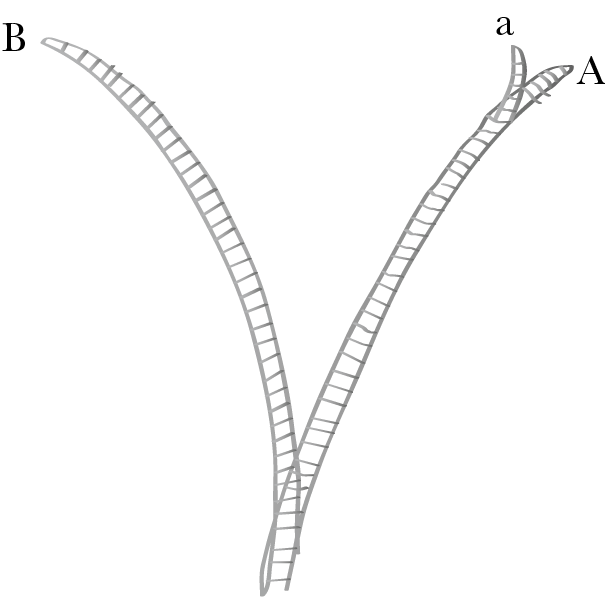From Francis Darwin 4 July 1879
Bot Institut | Würzburg
Friday July 4/79
Please ask G to order a copy of “Shakespeare’s C Merry Tales” to be sent to me here. I am not sure of the title— The German Humour man wants to see them1
My dear Father
Goebel says they ought strictly to be Prosheliism & Apheliism but he thinks there would be no harm in ‘helism’ with one i.2 The air roots of Monstera didn’t give any definite results none of them turned well but the best one was one with un-greased gold B’s skin3 I see from my notes about mustard roots in the winter, that caustic decidedly stopped aphelism the non-caustic ones all bending. I will try it here again. I sow mustard nearly every day now to have a stock for measuring— I have confirmed the fact that mustard roots grow quicker in darkness, by marking them at 10 mm in the am & measuring in evening as before.4 Now I have also mustard on a revolving disc & I measure the growth with a microscope like Vines did the mould & I think it will give neat results.5 I am also doing air roots of Chlorophytum (which I have cultivated in Nährstofflösung) with a microscope. And I shall tomorrow begin measuring the growing shoots of Tecoma radicans with are well (as you were)—aphelic. I have rigged up a tent to keep sun off & have got a dark & light bell &c all ready fitted to put together. If I can do that & the stems of Tropæolum I shall have enough for a decent paper.6 I quite agree with you that it is well worth while to prove that negative heliotropic things grow quicker in darkness. I am pleased that I have succeeded with mustard roots quite against Sach’s advice; first he said O they weren’t regularly aphelic, it was only a “pathologische Erscheinung”, & then “O you’ll never make out a difference in the growth of roots in light & dark Wolkoff worked very industriously at it & couldn’t succeed” I don’t know whether he will ask me to publish it in his Arbeiten & now I don’t care.7 I see it is a very good thing to be as independent of him as possible. I came to this conclusion before I heard about De Vries. Stahl works entirely in his own room, though many things he could do much better here, simply because he cannot stand being under Sachs in any way. He is very anxious to keep on perfect terms with Sachs & he finds the best way is only to see him when he (Stahl) is not working Stahl says he thinks it absolutely bad for anyone to work under Sachs unless they are of an independent nature8 I think you had better not repeat anything about Sachs and Stahl as I see Stahl is very cautious—for instance he said to me “Tell Ward (the Englishman) he ought to work under De Bary, he would do much better there, only don’t say I said so”9
One day I observed the movements of Oscillaria, which are Algæ consisting of
a row of cells, and which move about by a serpentine squirming movement;
they also make the most perfect circumnutation, each circle in about
40″10 It is very pretty to see the tip bend
over before the return movement begins. If A & B represent the two
extreme ends of a nutation,
 then when it has moved from B to A and is going to return, the
tip bends first as (a) & then the whole filament swings over. Stahl
believes this goes on by a change of tension without growth. I have
had
then when it has moved from B to A and is going to return, the
tip bends first as (a) & then the whole filament swings over. Stahl
believes this goes on by a change of tension without growth. I have
had
CD annotations
Footnotes
Bibliography
Berkel, Klaas van, et al. 1999. A history of science in the Netherlands: survey, themes, and reference. Leiden: Brill.
Darwin, Francis. 1880b. Über das Wachsthum negativ heliotropischer Wurzeln im Licht und im Finstern. Arbeiten des botanischen Instituts in Würzburg 2 (1878–82): 521–8.
NDB: Neue deutsche Biographie. Under the auspices of the Historical Commission of the Bavarian Academy of Sciences. 27 vols. (A–Wettiner) to date. Berlin: Duncker & Humblot. 1953–.
Oesterley, Herman, ed. 1866. Shakespeare’s jest book. A hundred mery talys, from the only perfect copy known. London: John Russell Smith.
Sachs, Julius. 1875a. Text-book of botany: morphological and physiological. Translated and annotated by Alfred W. Bennett, assisted by W. T. Thiselton-Dyer. Oxford: Clarendon Press.
Summary
Heliotropism nomenclature. Apheliotropic mustard roots grow more quickly in dark. Measures growth with microscope as S. H. Vines did in mould. Studying air roots.
FD’s and Stahl’s negative opinion of Sachs.
Letter details
- Letter no.
- DCP-LETT-12134
- From
- Francis Darwin
- To
- Charles Robert Darwin
- Sent from
- Würzburg
- Source of text
- DAR 209.3: 334
- Physical description
- AL 4pp †
Please cite as
Darwin Correspondence Project, “Letter no. 12134,” accessed on 18 April 2024, https://www.darwinproject.ac.uk/letter/?docId=letters/DCP-LETT-12134.xml


